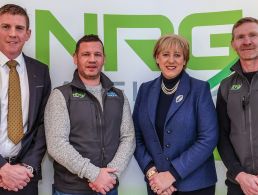Intel’s Marc Wall tells us about his role as a deep-learning engineer and the nature of work in pre-silicon verification.
For Marc Wall, there are many things he enjoys about being a deep-learning engineer.
“Although the challenges are many and the workload relentless due to the pace of adoption, the innovation, learnings and joy of being part of a team and company bringing life-changing products to people all over the world is a great feeling,” he says. “The fact that AI is so cutting edge and a transformational moment for tech is a bonus.”
Wall has 24 years of experience in hardware (HW) pre-silicon verification and design. He currently works at Intel’s Client Graphics and Artificial Intelligence Neural Processing Unit (NPU) as a deep-learning pre-silicon verification principal engineer.
If there is such a thing, can you describe a typical day in the job?
Some mornings I like to start the day with early morning exercise, I find this helps to keep me focused for the day and relieves stress. Keeping both physically and mentally fit is important in achieving a long and healthy career.
I would usually enter a day with a good idea of what is ahead from the day before, but checking for overnight meeting changes or urgent issues is a must as we work across multiple geographical locations and time zones. Plans can then be adjusted based on priority calls.
The day is usually made up of quite a few meetings (more than four meetings would be common) covering the current, past and future projects and previous discrete chips. With topics ranging from project-specific feature tracking, general status, scheduling/planning to pointed technical topics or task forces to solve a specific issue.
Outside of meetings, time is partitioned across specific technical tasks spanning multiple areas of verification as part of current program execution or previous generation support. The importance of cross-functional team alignment cannot be overstated, for example working closely with the software (SW) teams to ensure the best strategy is chosen when an AI model is mapped to run on the NPU.
What types of AI/analytics projects do you work on? Are there any you’re particularly enjoying, or have in the past?
I work on a low-power AI HW accelerator IP called the neural processing unit (NPU) found in the recently announced Intel Core Ultra processor. Sustained AI workloads can be offloaded from the central processing unit (CPU) to run efficiently on the NPU, freeing up the CPU for other tasks.
Working in pre-silicon verification means we are responsible for ensuring the quality of the IP prior to silicon production of the chip. There are many areas of pre-silicon verification including functional, formal, power, performance, numeric etc at different architectural levels to sign off the product prior to delivery into the SoC [system on chip] teams for integration.
It has been an amazing journey working on this technology over multiple generations from the initial NPU design whiteboard sessions in an office in Dublin. Being involved from the inception, watching the group grow, working with so many talented people across many functions, seeing the chip power on successfully without any significant HW bugs and culminating in the release of the AI PC Intel Core Ultra processor.
What AI/analytics skills do you use on a daily basis? Do you have to draw on any skills in ways you didn’t expect before you were in the role?
General AI/machine learning (ML) and network concepts are used when working on the HW side of AI to understand the different operator types used within a network model and how it maps to the HW for feature test planning. AI HW data processing and data movement along with a knowledge of data types are used in failure debug and numeric validation.
There are also more AI techniques being used in the tools that we use in verification of the design such as coverage closure and test efficiency/optimisation. These will continue to grow and be trialled and utilised.
What are the hardest parts of working in AI/analytics, and how do you navigate them?
New and evolving technologies like AI involve a lot of ‘firsts’, in that they have not been done before, leading to lots of challenges but also opportunities to innovate. The state space or possible configuration space is also immense, hence making coverage closure a challenge.
The fact that AI is a rapidly evolving landscape makes staying up to date a challenge, especially considering mapping these new concepts to HW that takes considerable time to get to market.
Working across functions in HW and SW helps to problem share and converge on solutions faster.
Do you have any productivity tips that help you through the day?
It is extremely important to plan your day based on priority calls and schedule commitments. Leverage the skills of your colleagues – we win and lose as a team. Attend only essential meetings to optimise productivity. Look after your health and mental wellbeing.
What skills and tools are you using to communicate daily with your colleagues?
Depending on whether or not we are onsite, interactions among the team members range from at the desk, in room and calls, to online Teams meetings. We have a good balance and need to be conscious that some team members are fully remote or in different locations in order to be as inclusive as possible.
We have a technically strong, dedicated and driven team who all bring a lot to the table. Ensuring open communications and listening to all opinions is critical to ensure we converge on the best solutions.
How has this role changed as the AI/analytics sector has grown and evolved?
With greater adoption and visibility of AI comes higher demand meaning more product intercepts, increased cadence etc. With this, my role has evolved and my scope has increased over my several years working in AI including driving different aspects of verification, gaining more expertise in new AI-specific data types (numerics) and researching new AI/ML tools and approaches that can be beneficial to pre-silicon verification.
What advice would you give to someone who wants to work in AI/analytics?
There is a bit of a ramp to entry but once the pieces start to fit, the journey will become easier.
Use the knowledge of your colleagues/team around you, we all started in the same place once, they will be happy to help.
Understand the requirements that best fit the functional disciplines across SW or HW in the AI space you wish to work in and focus on them, and set real expectations.
Enjoy it, it is not often you will get the opportunity to work on something so impactful.
Find out how emerging tech trends are transforming tomorrow with our new podcast, Future Human: The Series. Listen now on Spotify, on Apple or wherever you get your podcasts.




